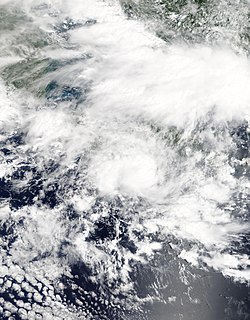
Indonesia is an island country in Southeast Asia and Oceania, located in the Pacific Ocean and the Indian Ocean. The largest island nation in the world, the country is the home of over seventeen thousand islands.
Contents
- Climatology
- Statistics
- 1970s
- 1980s
- 1990s
- 2000s
- 2010s
- 2020s
- Deadly storms
- See also
- References
- External links
Climatologically, in the Australian basin, most tropical cyclones develop between November and April, or as early as October and as late as May. However, there are some cases, most notably Typhoon Vamei, Cyclone Viyaru and Cyclone Senyar, where a tropical cyclone affected the nation from the north in either the Western Pacific or North Indian basins. This article includes all tropical cyclones of any intensity that affected the island nation of Indonesia, on all available records and data.
